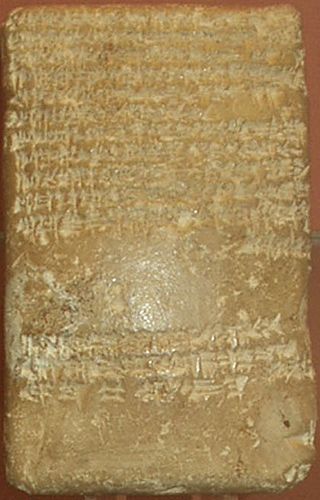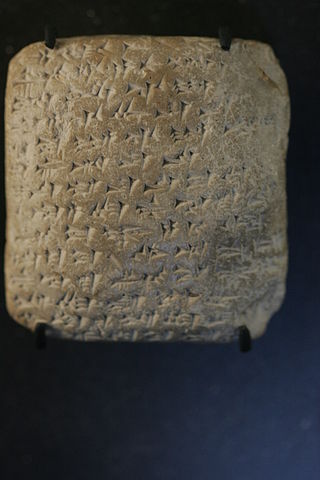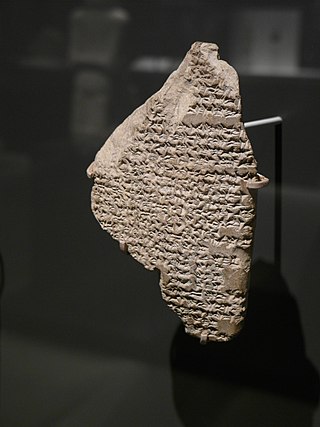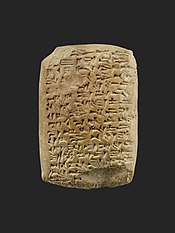
The Amarna letters are an archive, written on clay tablets, primarily consisting of diplomatic correspondence between the Egyptian administration and its representatives in Canaan and Amurru, or neighboring kingdom leaders, during the New Kingdom, spanning a period of no more than thirty years between c. 1360–1332 BC. The letters were found in Upper Egypt at el-Amarna, the modern name for the ancient Egyptian capital of Akhetaten, founded by pharaoh Akhenaten (1350s–1330s BC) during the Eighteenth Dynasty of Egypt.

Kadašman-Enlil I, typically rendered mka-dáš-man-dEN.LÍL in contemporary inscriptions, was a Kassite King of Babylon from ca. 1374 BC to 1360 BC, perhaps the 18th of the dynasty. He is known to have been a contemporary of Amenhotep III of Egypt, with whom he corresponded. This places Kadašman-Enlil securely to the first half of the 14th century BC by most standard chronologies.

Burna-Buriaš II, rendered in cuneiform as Bur-na- or Bur-ra-Bu-ri-ia-aš in royal inscriptions and letters, and meaning servant or protégé of the Lord of the lands in the Kassite language, where Buriaš is a Kassite storm god possibly corresponding to the Greek Boreas, was a king in the Kassite dynasty of Babylon, in a kingdom contemporarily called Karduniaš, ruling ca. 1359–1333 BC, where the Short and Middle chronologies have converged. Recorded as the 19th King to ascend the Kassite throne, he succeeded Kadašman-Enlil I, who was likely his father, and ruled for 27 years. He was a contemporary of the Egyptian Pharaohs Amenhotep III and Akhenaten. The proverb "the time of checking the books is the shepherds' ordeal" was attributed to him in a letter to the later king Esarhaddon from his agent Mar-Issar.

Amarna letter EA 19 is a tall clay tablet letter of 13 paragraphs, in relatively pristine condition, with some minor flaws on the clay, but a complete enough story that some included words can complete the story of the letter. Entitled "Love and Gold", the letter is about gold from Egypt, love between father-king ancestors and the current relationship between the King of Mitanni and the Pharaoh of Misri (Egypt), and marriage of women from King Tushratta of Mitanni to the Pharaoh of Egypt.

Amarna letter EA 161, titled An Absence Explained, is a tall clay tablet letter of 8 paragraphs, with single paragraphing lines. The surface is somewhat degraded, but most cuneiform signs that remain, allow for a relative complete translation context for the letter, and the eight paragraphs. The clay tablet is no. BM 29818 at the British Museum; the number is visible at the top of the tablet, above Para I-(in black ink, the top half of the number visible).

Amarna letter EA 9 is a tall, compact 38 line clay tablet letter of 3 paragraphs, in pristine condition, with few flaws on the clay. The photo of the reverse (pictured) shows half of Paragraph III, and some of the signs.

The cuneiform MEŠ, or meš is a plural form attached at the end of Mesopotamian cuneiform words as a suffix. As part of a name, or major class being referenced, in capital letters, it is typically separated from other capital letter Sumerograms with a period. The name of the group can follow, in lower case letters, for example:, LÚ.MEŠ–ma-as-sà-meš,.

Amarna letter EA 365, titled Furnishing Corvée Workers, is a squarish, mostly flat clay tablet, but thick enough (pillow-shaped), to contain text that continues toward the right margin, the right side of the obverse side, and also to the right side of the reverse side of the tablet.

Amarna letter EA 153, titled Ships on Hold, is a short-length clay tablet letter from Abimilku of the island of city-state Tyre.

Amarna letter EA 367, titled From the Pharaoh to a Vassal, is a medium-small, square clay tablet Amarna letter to Endaruta of Achshaph,, one of only about 10 letters of the el-Amarna corpus, that is from the Pharaoh of Egypt to his correspondent.

Amarna letter EA 144, titled: "Zimreddi of Sidon," is a square-shaped, mostly flat clay tablet letter written on both sides and the bottom edge. It is from a vassal state in Canaan, and is written by the 'mayor' of Sidon, the author of Amarna letter EA 144, and Amarna letter EA 145. Zimreddi is also referred to in a few other Amarna letters.

Amarna letter EA 289, titled: "A Reckoning Demanded," is a moderately tall, finely-inscribed clay tablet letter, approximately 6.5 in tall, from Abdi-Heba the mayor/ruler of Jerusalem, of the mid 14th century BC Amarna letters. The scribe of his six letters to Egypt were penned by the "Jerusalem scribe"; EA 289 is a moderately long, and involved letter, mentioning ten named individuals, some more than three times. A total of nine locations are referenced, as well as men of the "Hapiru"-("LÚ-MEŠ-Hapiru-ki"), and men of "Qilyi-ki".

Amarna letter EA 362, titled: "A Commissioner Murdered," is a finely-inscribed clay tablet letter from Rib-Haddi, the mayor/'man' of the city of Byblos,. Byblos, being a large coastal seaport Mediterranean city, was a city that was aligned with Egypt (Miṣri), and housed an Egyptian community. Rib-Haddi, as the city-state leader wrote the largest number of letters to the Pharaoh, in a sub-corpus of the 1350 BC Amarna letters.

Amarna letter EA 286, titled: "A Throne Granted, Not Inherited," is a tall, finely-inscribed clay tablet letter, approximately 8 in tall, and 3.5 in wide, from Abdi-Heba the mayor/ruler of Jerusalem, of the mid 14th century BC Amarna letters. The scribe of his six letters to Egypt were penned by the "Jerusalem scribe"; EA 286 is a moderately long, and involved letter.

Amarna letter EA 15, titled Assyria Joins the International Scene, is a shorter-length clay tablet Amarna letter from Ashur-uballit I of the Land of Assyria,. He addresses the Pharaoh in line 1, the "King (of) Land Miṣri-(Egypt)", thus the use of "Land (of) Assyria".

Amarna Letter EA5, one of the Amarna letters, is a correspondence between Kadašman-Enlil I and Amenhotep III.

Amarna letter EA 223, titled: "Compliance With Orders", is a very short clay tablet letter from Endaruta of city-state Akšapa (Achshaph). It is the only letter authored by Endaruta. One of the ten Pharaoh letters written to persons/ or states in the Amarna letters corpus, is Amarna letter EA 367.
Amarna letter EA 254, titled: "Neither Rebel nor Delinquent (2)", is a moderate length, tall, and mostly flat rectangular clay tablet Amarna letter,. The letter is from Labaya of city-state Šakmu . It is an undamaged letter, in pristine condition, with cuneiform script on almost all surfaces: Obverse, Bottom, Reverse, and Left Side. Letter EA 254 is numbered VAT 335, from the Vorderasiatisches Museum Berlin.

Amarna letter EA 288, titled Benign Neglect, is a tall, finely-inscribed clay tablet letter, approximately 7.5 in tall x 4.5 in wide, broken into two pieces, from Abdi-Heba the mayor/ruler of Jerusalem, of the mid 14th century BC Amarna letters. The scribe of his six letters to Egypt were penned by the "Jerusalem scribe"; EA 288 is a moderately long, and involved letter.

Amarna letter EA 290, titled: "Three Against One", is one of the two shorter letters, of six, from Abdi-Heba the governing man of Jerusalem. In the Jerusalem letters, Jerusalem is "Uru-Salem" ("City-Peace").






























